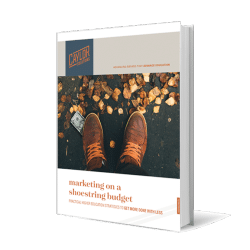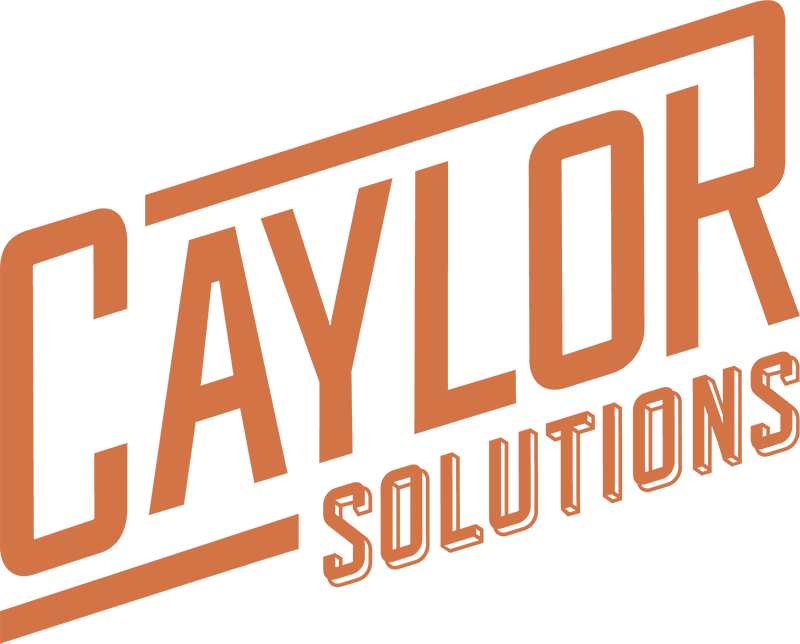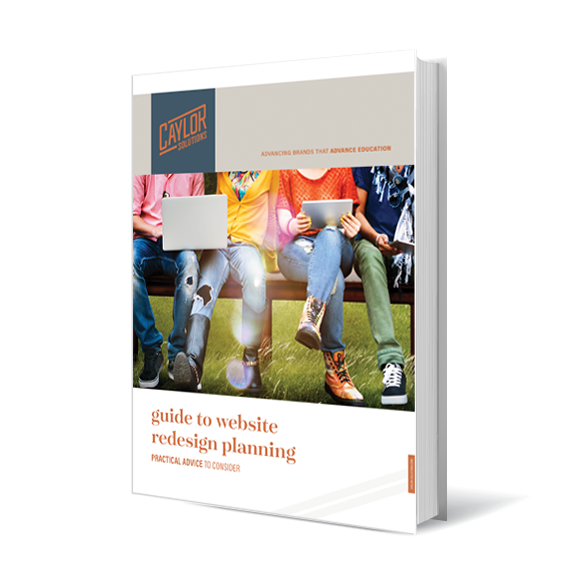Higher education marketing terminology is constantly growing and expanding.
There’s always some new technology or strategy disrupting the space with new terms that you’ve got to learn in order to keep up with it all.
But there are some foundational terms that every marketer should understand and use.
Maybe you’re new to education marketing.
Or, maybe you’ve got someone who’s brand-new to the team, and you’ve got to catch them up, fast.
I hope this starter guide to foundational marketing terminology can be helpful to you.
Marketing Terminology Starter Guide
- Brand
Your educational brand is a comprehensive term that is a combination of how your school is perceived and experienced by prospective students. Brand elements include your…
School ethos, campus atmosphere, brand promise, audience perceptions, history, and the marketing elements you use to express your brand (logo and other design elements).
- Brand awareness
The degree to which prospective students and their families know your school, your distinctives, and the marketing elements associated with your school.
- Lead
A person who is a potential student or the parents of a potential student. These are people who have engaged with your brand in some way and have given you at least one way (email, phone number, address, etc.) to unilaterally communicate with them.
- Marketing Persona
Enrollment marketing personas are profiles of imaginary persons who represent your audience.
They are a composite character made up of all the general traits that you know about your target audience(s) based on the information that you have in your files and some strategic guesses on your part.
You use these imaginary profiles to help guide your messaging and design decisions.
Some common personas for education marketers:
- The traditional student
- The non-traditional student or adult student
- The graduate student
- Moms and Dads
- Siblings
- Coaches
- Guidance Counselors
- Messaging
The language you use to communicate the promises you make to marketing personas, describe your education brand, and explain the opportunities at your school. Messaging would also include decisions on what kind of language you would NOT use.
- Content
Content is any kind of publication you create, digital or otherwise, which contains your messaging. This could include blog posts, email newsletters, social media posts, videos, print brochures and magazines, podcasts, and more.
- Call to action (CTA)
The action you want a user to take after they’ve seen or heard your content. Examples include subscribing to an email newsletter or submitting a contact form. Often, this will be made known directly in the copy and design.
- Copy / Copywriting
Copy is marketing terminology for the art and science of using words to motivate those viewing your content to action. This specific form of writing is crafted to evoke desire within prospective students and families to take the next step in their student journey.
- Student Journey / Marketing Funnel
The student journey is the process by which a potential student becomes aware of your education brand, engages with your content, and eventually decides to enroll or not.
Some schools extend the student journey to include the student’s time as a current student and as an alumnus.
To me, this is more consistent with the idea of a student lifecycle.
Whatever you call it, it’s important to somehow categorize the stages through which a student must go to understand your brand, love your brand, and choose your brand over the others.
- Analytics
In marketing terminology, analytics refers to how you analyze the data on how your audiences are interacting with your content and calls to action. This information normally comes from the social media platforms or the analytics tool you use to track users on your website and landing pages.
Typically, these analytics are compiled into a dashboard used by marketing leaders to make decisions on messaging and future campaigns.
- Campaign
Campaigns are a series of marketing activities (emails, social media posts, a mail-out flyer, etc.) you launch to achieve a specific goal, such as capturing new leads with a contact form or signing up more potential students for your campus tour.
- Hero Story / Testimonial / Student Spotlight
A testimonial is the experience of a person who loves your education brand. It is often a written or spoken statement expressing how your education brand helped them achieve their goals or become the person they wished to be. It can be as long as a 10 minute video or as short as a one sentence quote.
- Engagement
This is a complex marketing term. Engagement has to do with the connection you build with those who see or hear your content over time and is expressed when the content consumer performs an action such as commenting on a post, liking your page, clicking a link, or filling out a form.
- Unique selling proposition (USP) / Unique value proposition
A USP or a value proposition is a statement you create internally to help you express the value only your education brand can offer, as opposed to every other school out there. In a nutshell, it says what makes you different from all the other competitors.
- Return on investment (ROI)
Marketing costs money. Return on investment is a number, normally in monetary terms, which shows how much your marketing efforts brought into the schools minus the amount you spent.
While we shouldn’t be afraid of the numbers, I would caution you not to only focus on the monetary returns. More on that when we get to Key Performance Indicators.
- Inbound marketing
Inbound marketing is a marketing strategy where you create attractive content that prospective students and families find as they look for answers to their most pressing questions. With this strategy, prospective students and their families initiate the contact with you.
- Outbound marketing
Outbound marketing is a marketing strategy where you use multiple ways to contact prospective students and their families to introduce them to your education brand. This can be done through mailings, telemarketing, email prospecting, targeted ads, and more.
- Social media marketing
With this digital marketing method, you use social media platforms to connect to potential students and the general public to introduce them to your brand and build a relationship with your audiences on a mass level.
- Email marketing
This is just what it sounds like. Email marketing uses emails that you send to lists of prospective students to build a relationship with them and send them opportunities to interact with you.
- Content marketing
Content marketing is an inbound marketing strategy that relies on the content (blogs, videos, reports, etc.) you produce and publish to attract prospective students.
- Omnichannel marketing
Omnichannel marketing is more than just using all (omni) the marketing channels at your disposal. This strategy emphasizes the power of integrating all of your marketing channels during marketing campaigns.
An example would be a direct mail package you sent to prospective students with a QR code that sends the reader to your website or social media platforms where the campaign continues.
- Landing page
These are static, stand-alone website pages with a strong, obvious call to action and are used as a part of a larger marketing campaign. It’s normally the digital space where people “land” and are asked to perform a certain action.
- Chatbot
Chatbots are artificial intelligence Internet technologies which interact with visitors to your digital spaces, such as your website or social media platforms.
They normally work by scanning chat messages from your visitors or followers to identify certain keywords and topics of interest and then send back pre-written responses from your team. Chatbots should be used strategically and as an auxiliary to your marketing team, not as a replacement.
- Bounce rate
Unfortunately, not everyone who lands on your website or other digital spaces will stay to consume your content and respond to your calls to action. Bounce rate is the percentage of visitors who leave your site after viewing only one page.
- Click-through rate (CTR)
Percentage of users that click on an ad after seeing it.
- Lead magnet
A lead magnet is a piece of content, such as a study or guide, or a tool, like a college cost calculator, that you can use to incentivize visitors to perform certain actions such as filling out a form.
- Search engine optimization (SEO)
Search engine optimization is the method of using keyword and content tactics to make it more likely that search engines like Google will show your content in online search results.
- Blog
You’re reading a blog post right now! This is part of an online journal of posts called a blog.
- Vlog
Video blog. Instead of writing content, you create videos that attract people to your digital spaces.
- Conversion rate
The percentage of users that follow through on your call to action like clicking on a link or signing up for a campus visit.
- Key performance indicator (KPI)
Key performance indicators are other ways to measure marketing success besides the return on investment. KPI’s could be the number of applications you receive, the number of deposited students, or the number of comments you’re getting on your social media posts.
KPI’s will vary from school to school as education marketers determine the main areas of their digital marketing that need help.
- Metrics
Metrics are any kind of measurement you collect on your audiences’ behavior. These data are analyzed to determine how well your marketing campaigns are doing. Common metrics include click-through rate, cost per lead, bounce rate and conversion rate.
- Customer acquisition cost (CAC)
While this marketing terminology looks like it’s too corporate for education marketing, it is an important concept. Essentially, the customer acquisition cost is the amount of money you spend to introduce prospective students to your brand, show them what you’re all about, and convince them to enroll in your school. You can use this metric to determine the overall effectiveness of your marketing strategies.
This is not an exhaustive list of marketing terminology!
There’s just no way to list all of the terms a good education marketer will need to know in one post!
I’m sure you’ve scanned through this list and can think of many more terms that I’ve left off.
But I think that this is a good starter list for most education marketers.
What would you add to the list?
For more information on more effective education marketing, please contact us today!
Market More. Spend Less.
Set yourself free from your shrinking marketing budget with my popular ebook Marketing on a Shoestring Budget! This ebook is jammed with practical ways to produce high-quality marketing on the cheap.
Inside, I’ll show you proven marketing tactics like…
-
- How to leverage low-cost technologies to reach your target market,
- How to craft a content marketing strategy on a bare-bones budget,
- The number one thing your website needs to do,
- The key to getting free, organic traffic to your website, and more.
No hype. No pie in the sky. Just real solutions for getting the job done with the budget you’ve got.
Featured image by Artur via Adobe Stock











